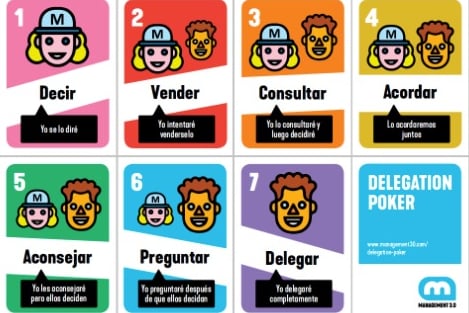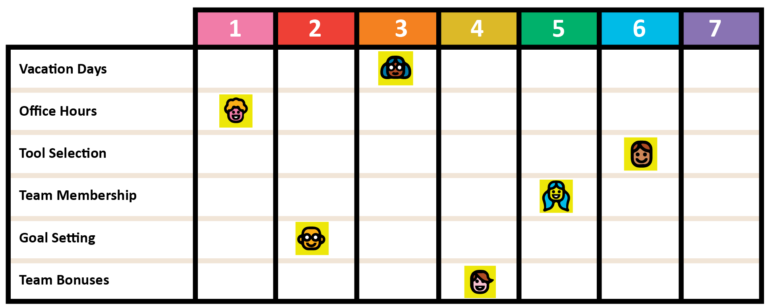Empowering teams with Delegation Poker & Delegation Board
Building more robust, flexible, efficient, and creative systems through delegation and empowerment of people.
MANAGEMENT 3.0
Lautaro Martín
2/18/20253 min read
Introduction
In my pleasant experience working and collaborating with different teams, especially those seeking to evolve through continuous improvement, one of the main issues that arises in this regard concerns authority and how decisions are made.
This is because it is often unclear who is responsible for what and to what extent, which creates gray areas, confusion, and often demotivation and delays.
To address this issue, it is key to encourage conversations about decision-making with the goal of clearly defining the levels of delegation and authority for each team, and this is where Delegation Poker and Delegation Board become powerful tools.
What are Delegation Poker and Delegation Board?
🔹 Delegation Poker is a dynamic poker card game that helps teams and leaders jointly define delegation levels for key decision-making areas.
Cards with seven levels of delegation are used, ranging from Level 1: "Tell me what to do" to Level 7: "I will decide."
In between these values, there is a symmetrical gradient of options that allow us to fine-tune the exact point at which we seek to delegate authority for a key decision-making action to the team.
The practice consists of selecting those topics relevant to decision-making and, through a deck of cards and based on each participant's experience on the topic, each participant individually demonstrates the degree of delegation of authority that this action requires for the well-being of the team.
The cards, the gradients of delegation, are te followings:
1. Tell
You make a decision for others and then explain your motivation.
No debate is desired or expected.omas una decisión por los demás y explicas luego tu motivación.
2. Sell
You make a decision for others, but you try to convince them that you made the right decision and help them feel involved.
3. Consult
First, he asks for opinions, which he takes into account before making a decision that respects people's opinions.
4. Agree
You enter into a discussion with everyone involved and, as a group, you reach a consensus on the decision.
5. Aadvise
You will offer your opinion to others and hope they will listen to your words of wisdom, but it will be their decision, not yours.
6. Inquire
First he lets others decide and then asks them (questions) to convince him of the wisdom of their decision.
7. Delegate
You leave the decision up to them and don't even want to know details that would just clutter your brain.
🔹 The Delegation Board is a Management 3.0 visual dashboard that helps teams and leaders clarify levels of autonomy and decision-making within an organization. Its purpose is to balance trust and control, promoting a culture of shared responsibility and empowerment.
How does it work?
This is a matrix that shows:
📌 Tasks or decision areas (rows) – Example: hiring, budget, product priorities, vacations, etc.
📌 Levels of delegation (columns) – From level 1 (the leader makes sole decisions) to level 7 (the team makes complete decisions).e trata de una matriz que muestra:
Each team or organization defines its own Delegation Board based on its needs. The important thing is that this board serves as a communication tool or a source of information and alignment on how decisions are made.
Important: The Delegation Board is not static. Ideally, it should be reviewed periodically to adjust to team growth and organizational changes.
Why use these practices?
✅ Promotes transparency and trust.
✅ Reduces ambiguity in decision-making.
✅ Empower teams, avoiding micromanagement.
✅ Facilitates the evolution of leadership based on the maturity of the team.
✅ Increases people's motivation by making them feel empowered.
How to implement this practice?
1️⃣ Identify key decisions within the team (e.g., hiring, tools, priorities, vacations, etc.).
2️⃣ Distribute decks of cards with the 7 delegation levels to each participant to begin playing Delegation Poker and discuss and agree on delegation levels.
3️⃣ Record the results in a Delegation Board visible to all.
4️⃣ Periodically review the board to adapt to changes.
Make the resulting Delegation Board visible to everyone as an information radiator to make the information transparent.
Conclusions
💡 Discussions are just as important as results as they help us align expectations.
💡 Trust and motivation within teams increases because rules are agreed upon and clearly communicated.
💡 Clearly delegating authority and decision-making empowers and motivates people.
💡 Distributed systems are most powerful when authority is distributed throughout the system and not concentrated in a central node.
💡 Periodically reviewing the Delegation Board allows you to evolve with the team.
👉 Have you used these practices on your team? Tell me about your experience in the comments!! 🚀






